Chicano Park
Introduction
Text-to-speech Audio
Chicano Park, located in the Barrio Logan neighborhood of San Diego, is a historic site renowned for its vibrant murals and cultural significance. The park was formally established on April 22, 1970 and its historical significance was solidified during the Chicano Civil Rights Movement when residents rallied against the planned construction of a California Highway Patrol station on the proposed site. Their advocacy not only saved the park from destruction but also led to the establishment of a grassroots movement that transformed the site into a symbol of resistance, cultural pride, and social justice. Notable muralists, including Los Toltecas en Aztlan and Victor Ochoa, have contributed to the park's iconic artwork, reflecting the struggles and triumphs of the Chicano community. Additionally, the murals depict themes of heritage, identity, and the fight against social inequality, making the park a living testament to the Chicano experience. The spirit and imagination of a people took this land and transformed it into a park of monumental murals that represents the largest collection of outdoor murals in the world and is now listed by the National Register of Historic Places worthy of preservation. Open to the public, Chicano Park stands as a free and accessible space, serving as both an outdoor art gallery and a historical landmark that educates visitors about the Chicano movement's impact on the local and national narrative.
Images
Mural Name: "All The Way To The Bay" (1978). Artist Name: Victor Ochoa. Credit: Go San Diego Website
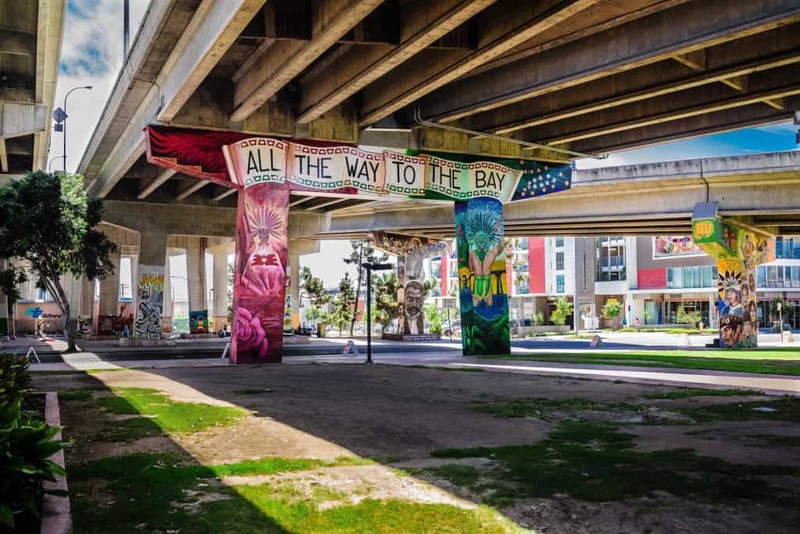
Credit: San Diego Explorer Website
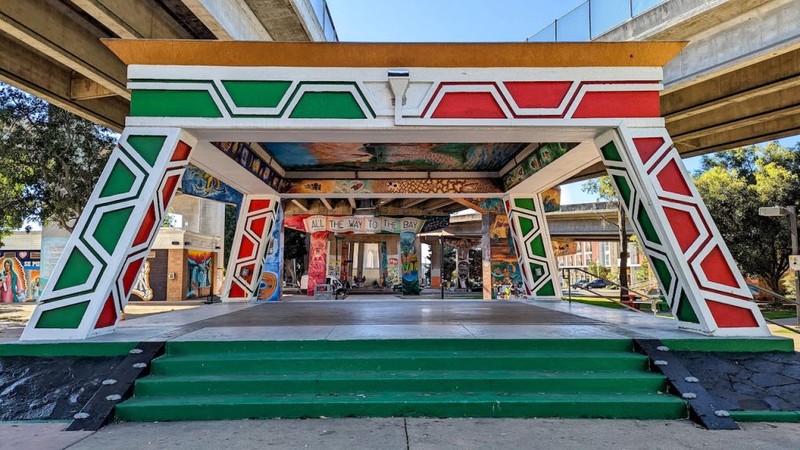
Mural Name: "Nacimiento Del Parque Chicano" (1978). Artist Name: Dolores Serrano. Credit: Calexico Chronicle Website
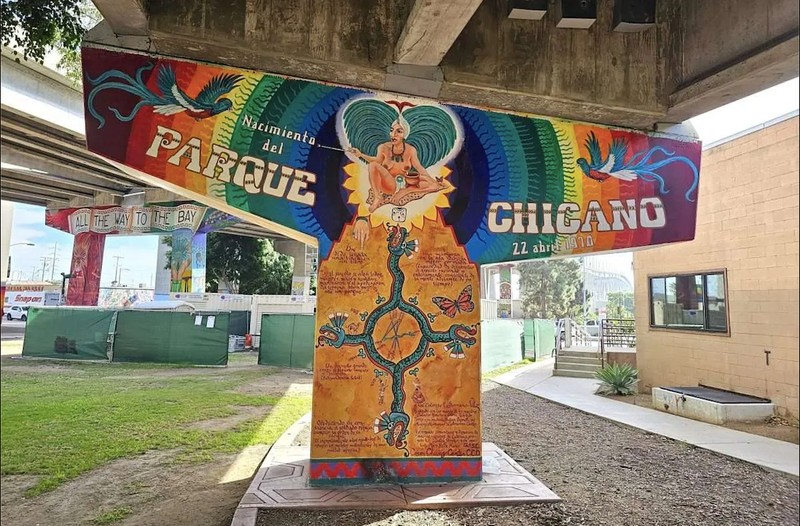
Credit: Chicano Park Museum and Cultural Center Website
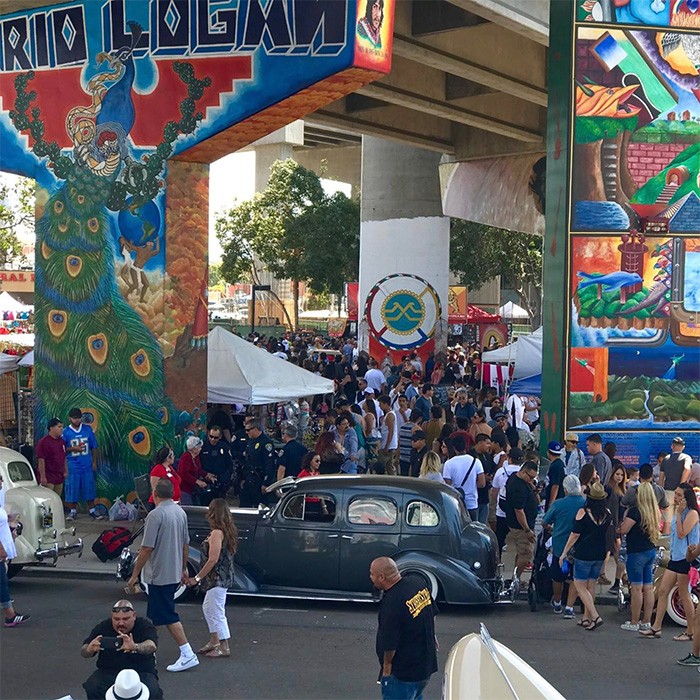
Mural Name: "Historical Mural" (1973). Artist Names: Toltecas en Aztlán, Salvador Barajas, Guillermo Aranda, Arturo Román, Victor Ochoa, José Cervantes, Guillermo Rosette, Gilbert “Magu” Lujan, Daniel de Los Reyes and M.E.Ch.A.-UC Irvine Restoration: Sal Barajas, Guillermo Rosette, Guillermo Aranda, Victor Ochoa, Armando Nuñez, Eddie Galindo and Hector Villegas, 2012. Credit: Chicano Park Museum and Cultural Center Website
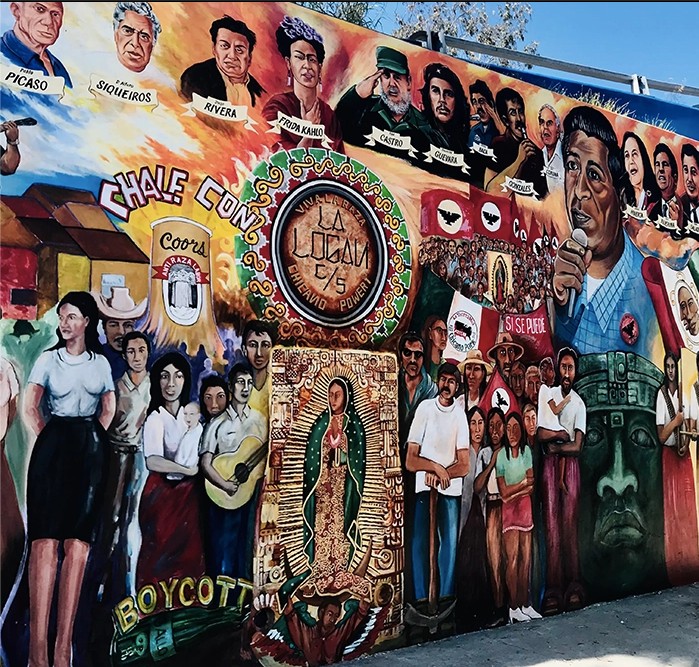
"Map of Chicano Park" Credit: Chicano Park Steering Committee Website
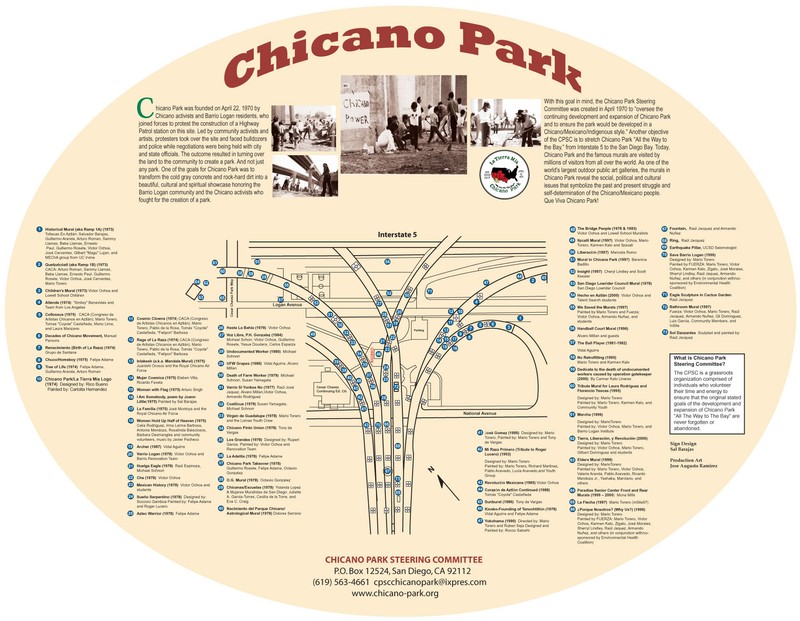
Art by Valerie Ruiz, Credit: Chicano Park Steering Committee Website
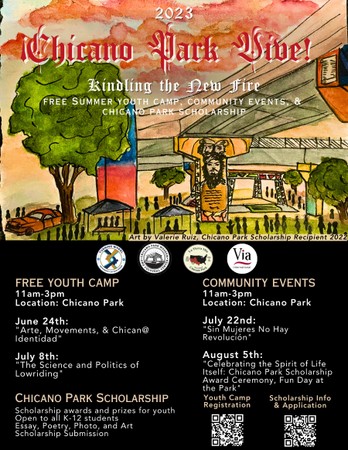
Backstory and Context
Text-to-speech Audio
The history of Chicano Park displays the moving story of a struggle over land and in the process gives insight into the politics of community organizing and the revitalizing effects of discovering ethnic identity. Hidden under the I-5 Freeway and the Coronado Bridge in Barrio Logan, located just south of Downtown San Diego, California, is the small park filled with colorful murals. It is these impactful paintings that tell the history of the park, including its turbulent beginnings. Chicano Park, more than just a physical space, is a testament to the resilience of a community that faced displacement and adversity. The murals, vibrant and powerful, serve as visual narratives documenting the journey from the destructive forces of urban development to the triumphant establishment of a cultural haven.
Chicano Park, situated in what was once known as Logan Heights (and is now known to residents as Barrio Logan), boasts a rich history rooted in the settlement of Mexican-American communities in San Diego. Dating back to the late 19th century, Logan Heights drew in thousands of Mexican immigrants and Chicanos, who were lured by its proximity to Downtown San Diego and its upscale residential character. For generations, Logan Heights' Chicano community flourished as a tight-knit, self-sustaining neighborhood. Mexicans had been integral members of this community, with an increasing influx since the 1930s, encompassing laborers, cannery workers, welders, pipe-fitters, longshoremen, and various other professions. Logan Heights’ proximity to two expanding naval stations on San Diego Bay—the Thirty-Second Street Naval Station and the North Island Naval Air Station on the nearby island of Coronado—made the neighborhood vulnerable to mega projects, especially during the war years. Its subsequent rezoning by the San Diego City Council in 1957 from a residential to an industrial district brought further unwelcome changes, including several scrap yards where refuse from nearby shipbuilding plants piled up. During this time, whites fled the neighborhood for newer suburban areas, and Mexican immigrants and Chicanos moved in, making Logan Heights the nation’s second-largest urban concentration of Mexican-origin people by the mid-1960s.
The interstate era brought further changes to the neighborhood landscape. The California Division of Highways, aggressive in its effort to build a state-of-the-art highway infrastructure, especially in the cities, noted that the industrial and military character of Logan Heights was well suited for a new transportation corridor. With a master plan for some three hundred miles of new freeways in the San Diego urban region, the Division of Highways began in the early 1950s with the construction of I-5, the city’s primary traffic artery that ran north from the Mexican border, through the heart of Logan Heights, and skirting downtown San Diego on its way to Los Angeles, Sacramento, Portland, and Seattle. Initially, the community lacked the means to resist the construction, but the political landscape shifted with the rise of the Civil Rights Movement and the Chicano Movement. In 1968, the construction of the Coronado Bridge further disrupted Barrio Logan, yet the community had developed a keen political sense and attachment to the place. Protests against the bridge's impact led to a grassroots struggle for identity and place-making. After much protesting and petitioning, activists and residents of Barrio Logan convinced the State of California (the legal owner of the property) to create a neighborhood park on the land adjacent to I-5 and directly beneath the Coronado Bridge. Within one year, however, the State reversed its decision and instead pledged the land to the California Highway Patrol.
Since at least 1967, a prevailing belief among Barrio Logan residents was that they would receive a portion of land for a park. The formal push for a park in Barrio Logan commenced on April 22, 1970, led by José Gomez, a long-standing neighborhood resident. Joined by students, families, and children, they took over the land beneath the approach ramps of the San Diego-Coronado Bay Bridge upon discovering plans for a California Highway Patrol station. Approximately 250 to 500 individuals, representing a diverse cross-section of the community, disrupted ongoing grading work, occupying the site for twelve days. Their demand was clear: an immediate establishment of a park. To underscore this, the occupiers actively began preparing the ground for grass, shrubs, and flowers, using shovels, pickaxes, hoes, and rakes. Establishing the Chicano Park Steering Committee, these activists insisted that the property be donated to the Mexican-American community, emphasizing its significance as a park for expressing Hispanic culture through art. In 1970, the City of San Diego, responding to the residents' concerns, secured the disputed property, and in collaboration with the community, established Chicano Park as a nonprofit open-space project. This marked a significant triumph for Barrio Logan, embodying the spirit of resilience and activism in reclaiming a space that became a symbolic nexus of Chicano identity and pride.
On March 23, 1973, mural making in Chicano Park began in earnest. Modern Chicano muralism grew out of a desire for change and was typically centered in barrios and ghettos of inner cities. Muralism inspired efforts to reclaim a community’s cultural heritage and was used as a means to develop individual and community self-pride. The height of Chicano political activism occurred between 1969 and 1975 and not only dictated the specific social and economic issues the movement dealt with but also coincided with the most productive period of Chicano muralism. Certainly, this was the historical context in which the Chicano Park murals fit. At the park, two teams of Chicano artists, Los Toltecas en Aztlan, and El Congreso de Artistas Chicanos en Aztlan, commenced the painting in the area, beginning with the bridge’s off-ramps. The murals in Chicano Park were executed over an extended period and in three main phases. The first phase of mural making, 1973–1974, involved two Chicano art collectives (noted above). The second phase in 1974–1975 included invited artists from communities throughout California, most notably Los Angeles and Sacramento. An infusion of new ideas resulted from this period. The third mural phase, 1977–1981, celebrated a resurgence in community pride by, for example, questioning the inordinate number of junkyards in the barrio and their visual and audio impacts on the quality of life. Marked by a twenty-day Mural Marathon organized by Victor Ochoa in 1978, this third phase utilized the skills of some non-Chicanos and emphasized educational and historical themes. The murals, painted on support pillars, walls, and walkways, have quite successfully masked the stark imposition of the freeway and “cold grey concrete” of the Coronado Bridge. Visual themes depicting struggles of the past and present create an overarching narrative intended to offer an expressive form of empowerment to the residents of the surrounding neighborhood. By early 1984, a group of artists led by Salvador Torres and Mario Torero and members of the Chicano Park Arts Committee began the work of touching up the murals. In 1991, the California Department of Transportation trained numerous artists in repair techniques. Mural restorations in Chicano Park still take place today. The 2023 Mural Restoration Project is now in full swing. The Chicano Park Steering Committee will be restoring 20 murals as well as sculptural/architectural pieces in collaboration with the original artists to ensure they can continue to educate people for generations to come.
In conclusion, Chicano Park stands as a living testament to the resilience and activism of the Barrio Logan community. Its vibrant murals, born out of the Chicano Civil Rights Movement, not only saved the park from destruction but also transformed it into a symbol of resistance, cultural pride, and social justice. Today, Chicano Park continues to be a dynamic space where community events and mural restorations take place, ensuring that the rich history and cultural significance embedded in the artwork endure, educating and inspiring generations to come. The park remains a powerful expression of the Chicano experience and a vital part of San Diego's cultural landscape.
Sources
Amer, Tarecq. "Resisting, Reclaiming, and Asserting Democracy: The Case of Chicano Park." The International Journal of the Constructed Environment 2, no. 2 (2012): 1-20. https://doi org.proxy.library.nd.edu/10.18848/2154-8587/CGP/v02i02/37524.
Avila, Eric. “Taking Back the Freeway: Strategies of Adaptation and Improvisation.” In The Folklore of the Freeway: Race and Revolt in the Modernist City, 149–180. Minneapolis: University of Minnesota Press, 2014. http://www.jstor.org/stable/10.5749/j.ctt6wr7hb.9.
Department of Ethnic Studies. Chicano Park 2015 Murals Documentation Project: Guide To The Murals of Chicano Park. University of San Diego Ethnic Studies Books, 2015.
Kenny, John Eugene. "The Chicano Mural Movement of the Southwest: Populist Public Art and Chicano Political Activism." Order No. 3253092, University of New Orleans, 2006.
Kühne, Olaf, Antje Schönwald, and Corinna Jenal. “Bottom-up Memorial Landscapes between Social Protest and Top-down Tourist Destination: The Case of Chicano Park in San Diego (California)–An Analysis Based on Ralf Dahrendorf’s Conflict Theory.” Landscape Research 48, no. 5 (2023): 615–31. https://doi.org/10.1080/01426397.2022.2069731.
Octaviano Quintero, “April 22, Chicano Park Anniversary,” Triton Times, April 11, 1972, 1.
Patricia Reyes, “Chicano Community to Build a Park,” Triton Times, May 1, 1970, 7.
Rosen, Martin D., and James Fisher. “Chicano Park and the Chicano Park Murals: Barrio Logan, City of San Diego, California.” The Public Historian 23, no. 4 (2001): 91–111. https://doi.org/10.1525/tph.2001.23.4.91.
Ryan, Susan. "Chicano Park." Cineaste 1992, 66-66,60, http://proxy.library.nd.edu/log in?url=https://www-proquest-com.proxy.library.nd.edu/magazines/chicano-park/docview/222693696/se-2.
Smith, Peggy Jeanne. "Chicano Park: Myths, Meanings and Memories." Order No. 1404136, California State University, Fullerton, 2001.
https://www.gosandiego.com/blog/chicano-park-from-embattled-undeveloped-land-to-national-historic-landmark/.
https://sandiegoexplorer.com/chicano-park-san-diego/.
https://calexicochronicle.com/2023/10/01/colorful-chicano-park-born-of-struggle-over-racial-injustice/.
https://sandiegomuseumcouncil.org/museums/chicano-park-museum-and-cultural-center/.
https://sandiegomuseumcouncil.org/museums/chicano-park-museum-and-cultural-center/.
https://chicano-park.com/cpscwhatisthe.html.
https://chicano-park.com/.
